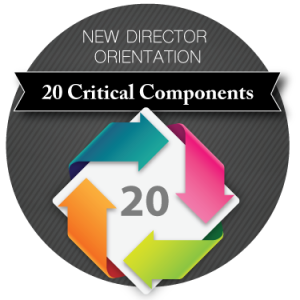Anyone who has served on a nonprofit board, will know this feeling all too well. We’ve all been there… suffering through a board meeting that makes a root canal seem like a night on the town. Whatever the reason, too many board meetings feel like a waste of time with little being accomplished.
Progress can be so slow it feels like the minutes of your life are just fading away, leaving you wondering why you’re even there. Decisions aren’t being made, no one is actively engaged, you’re listening to a laundry list of challenges that never seem to go away, and you’ll end up leaving this board meeting with the same question you always have… “Why did I need to be here?” On top of that, chances are other nonprofit boards have been asking you to serve, and from the outside they seem to have their act together in ways your current board does not. You can’t help but wonder if perhaps your time is better spent elsewhere.
So is there a way to make your board meetings better? Is there hope for turning them into something meaningful, where you can contribute, and use your leadership skills to help move the organization forward? In my experience with nonprofits, I see a number of challenges with board meetings, but here are the Top 10 — along with ways you can fix them in your organization.
Top 10 Board Meeting Challenges & How to Fix Them
Challenge 1. Directors come to meetings poorly prepared.
How can you fix this? Announce that to make the next meeting more effective you will automatically assume all material has been read in advance and no time will be provided for people to read it during the meeting. Meetings are to discuss — not find out about — issues. To help with this challenge, ensure all meeting documents are emailed out 7 days before the meeting. A quick follow-up reminder email sent to all board attendees 3 days before the meeting can also help people refresh on the items that will be discussed.
Challenge 2. Some heavy-handed, or long-term directors use undue influence in discussions and decision-making, drowning out other’s discussions.
How can you fix this? Instituting term limits can be one of the best ways to curb this challenge. By enforcing term limits — such as a 2 or 3 year term — your leadership team — and board meetings — will remain “fresh” with more new ideas and engaged discussion.
Challenge 3. Little or no use of committees.
How can you fix this? Your board should not be attempting to accomplish everything as a whole. Breaking the team down into sub-groups or committees — created for specific goals, can be a much more effective way to get things done. Committee meetings are where the heavy lifting takes place, reporting its efforts and/or findings to the rest of the board for its consideration. Planning your next big fundraiser? Assemble an event committee to work out the details and research for this event. Involve the whole board only when deciding on major decisions — such as a venue, etc. Leave all the details and planning to the committee and let them report back during board meetings.
Challenge 4. Poorly led meetings.
How can you fix this? Board chairs must manage meetings so no one takes over the discussion, so each board member feels included, and so topics are dealt with and dispatched in a timely basis. An agenda created and distributed ahead of the meeting — and followed closely during the meeting — can go a long way to help keep the meeting on track.
Challenge 5. No decisions get made…Unending discussions pushing for the perfect decision get in the way of a good decision made in far less time.
How can you fix this? Eventually the board chair has to call for a vote on lingering issues. You will never have all the information available so make the best decision with what you have. Waiting too long for a perfect decision can actually cause you to miss out on an opportunity.
Challenge 6. Getting bogged down in details that are staff responsibility.
How can you fix this? Board meetings should not be the place where things like the color of the napkins at the annual gala is discussed. Keep in mind — all decisions are not board decisions. Empower your key staff, committee members, and even specific volunteers, to make good decisions, within their area, to free up the board for more strategic thinking.
Challenge 7. Majoring in the minors—Avoiding the real issues and sticking with safe topics as long as possible.
How can you fix this? Significant issues only get worse, so they should be taken on directly and not covered up with busywork surrounding relatively minor topics. Is your organization struggling to cover expenses after the loss of a significant donor? Do you have a key staff member that needs to be let go because they are under performing? These are critical issues that likely need to be discussed with the board, where as discussing the colors for your new brand over-haul should likely be tabled for the next meeting.
Challenge 8. Not holding directors accountable for what they have committed to do.
How can you fix this? The board chair should be sure assignments and deadlines are documented in meeting minutes and revisited at subsequent meetings for progress updates. If possible, get each director involved in something. This way no one is singled out during board meetings. You can go around the room and get a progress update from each individual. If you have a challenge with one director not delivering, meet with them one-on-one and find out what the issue is.
Challenge 9. Not following their own policies or making exceptions all the time.
How can you fix this? Setting policy and not following it is a sure way to encourage disarray and possible legal problems down the line. Do you have a policy about board members only serving for a 2 year term, but you’re allowing certain individuals to remain for 3, 4, or even 5 years? Lack of follow through on policies can create confusion on your leadership team and within your organization.
Challenge 10. Not conducting annual board and director assessments.
How can you fix this? The board development or governance committee should ensure each director receives feedback on their performance on a regular basis. Also, the board as a whole should evaluate how it is performing. Appropriate steps should be taken to fix any problems that surface.
Does your board measure up?
One way to address board performance issues is to conduct an assessment of your organization. The Break Through evaluation will give you a quick score to provide insight into how your board (and organization) is doing.

Ready to kick your board into high-gear?
Develop your own Board Orientation system and create a Board Development Committee to help new directors get off on the right foot, as well as re-inspire longer-term directors.


